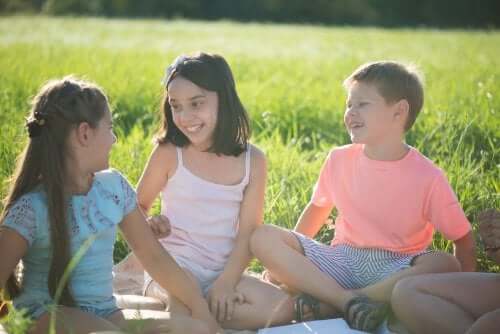The Different Types of Socialization


Written and verified by the pedagogue and trainer María Matilde
There are different types of socialization, depending on where we are or what stage of life we’re in. In this article, we’ll talk about primary, secondary and tertiary socialization.
Types of socialization
Socialization is the process where people learn the sociocultural elements of their environment. It involves internalizing the norms and values of society and culture, and adding them to your own personality.
Socialization happens through constantly interacting with people in the different social institutions that make up society. In fact, family and school are the first places where we learn how to be a part of society.
As we said earlier, these types of socialization depend on different social institutions. For example, some of these are family, school and media. Also, they depend on the age range or stage of life you’re in.

Types of socialization: primary, secondary and tertiary
Primary socialization
You might say that primary socialization is the most important since it’s the first stage you go through in childhood. It’s kids’ introduction to society, and what they will base all other social interactions on.
In primary socialization, you internalize a social “objective world.” Here, family is the main socializing agent.
The family nucleus takes care of kids’ physical needs. Also, it’s where kids evolve and grow. In this way, they develop at the cognitive, social, psychological and personal levels. In addition, they form certain behavior patterns.
The main characteristic of primary socialization is that it influences kids’ socio-evolutionary development. Although it reflects the family’s characteristics, it’s related to factors like the socioeconomic level, educational levels, religious, moral and social values.
Secondary socialization
Secondary socialization comes next. Once the person is already socialized, they enter a new part of society. In fact, this is the entrance to the academic world, and it’s an important change for people. Now, the school is the main socializing agent.
School involves learning and internalizing social norms and values. They reinforce, and sometimes go against, what you learn in primary socialization. School is the formal setting where you learn culture, authority and hierarchies, and certain behavioral patterns.
Secondary socialization and peers
School is where social relationships develop and peer groups form. These are made up of friends and schoolmates. Kids will start to spend more time with their friends, making them the main socializing agent too.
Peer groups provide the ability to share hobbies, and are a key source of compassion and understanding. Also, peer groups are the most important stage to create your identity and personality.

Peer groups form as a subculture that have strong loyalties, their own codes, fashion and ways of behaving. In the group, kids often want to be independent and autonomous, mainly against their parents.
In addition to school and their friends, the media is very powerful. Thanks to technology and social networks, information is readily available. You can easily see fads, values and lifestyles that people with lots of influence promote.
Tertiary socialization
Some authors talk about a third type of socialization in people, which begins with old age and goes into retirement. In fact, this is because their routines and daily social interactions change.
On the other hand, other authors say that tertiary socialization happens to people who aren’t a part of the social norm. For example, this happens in people who commit crimes and go to jail. There, they have to re-socialize to reintegrate into society.
Finally, the social agents in charge of it are the competent and professional authorities that are a part of prisons. This includes psychiatrists, doctors, psychologists, social workers, and others.
There are different types of socialization, depending on where we are or what stage of life we’re in. In this article, we’ll talk about primary, secondary and tertiary socialization.
Types of socialization
Socialization is the process where people learn the sociocultural elements of their environment. It involves internalizing the norms and values of society and culture, and adding them to your own personality.
Socialization happens through constantly interacting with people in the different social institutions that make up society. In fact, family and school are the first places where we learn how to be a part of society.
As we said earlier, these types of socialization depend on different social institutions. For example, some of these are family, school and media. Also, they depend on the age range or stage of life you’re in.

Types of socialization: primary, secondary and tertiary
Primary socialization
You might say that primary socialization is the most important since it’s the first stage you go through in childhood. It’s kids’ introduction to society, and what they will base all other social interactions on.
In primary socialization, you internalize a social “objective world.” Here, family is the main socializing agent.
The family nucleus takes care of kids’ physical needs. Also, it’s where kids evolve and grow. In this way, they develop at the cognitive, social, psychological and personal levels. In addition, they form certain behavior patterns.
The main characteristic of primary socialization is that it influences kids’ socio-evolutionary development. Although it reflects the family’s characteristics, it’s related to factors like the socioeconomic level, educational levels, religious, moral and social values.
Secondary socialization
Secondary socialization comes next. Once the person is already socialized, they enter a new part of society. In fact, this is the entrance to the academic world, and it’s an important change for people. Now, the school is the main socializing agent.
School involves learning and internalizing social norms and values. They reinforce, and sometimes go against, what you learn in primary socialization. School is the formal setting where you learn culture, authority and hierarchies, and certain behavioral patterns.
Secondary socialization and peers
School is where social relationships develop and peer groups form. These are made up of friends and schoolmates. Kids will start to spend more time with their friends, making them the main socializing agent too.
Peer groups provide the ability to share hobbies, and are a key source of compassion and understanding. Also, peer groups are the most important stage to create your identity and personality.

Peer groups form as a subculture that have strong loyalties, their own codes, fashion and ways of behaving. In the group, kids often want to be independent and autonomous, mainly against their parents.
In addition to school and their friends, the media is very powerful. Thanks to technology and social networks, information is readily available. You can easily see fads, values and lifestyles that people with lots of influence promote.
Tertiary socialization
Some authors talk about a third type of socialization in people, which begins with old age and goes into retirement. In fact, this is because their routines and daily social interactions change.
On the other hand, other authors say that tertiary socialization happens to people who aren’t a part of the social norm. For example, this happens in people who commit crimes and go to jail. There, they have to re-socialize to reintegrate into society.
Finally, the social agents in charge of it are the competent and professional authorities that are a part of prisons. This includes psychiatrists, doctors, psychologists, social workers, and others.
All cited sources were thoroughly reviewed by our team to ensure their quality, reliability, currency, and validity. The bibliography of this article was considered reliable and of academic or scientific accuracy.
- Andréu Abela, J. (2003). Infancia socialización familiar y nuevas tecnologías de la comunicación. http://rabida.uhu.es/dspace/bitstream/handle/10272/156/b15148312.pdf?sequence=1
- de Madrid, C. (2018) Subculturas juveniles: identidad, idolatrías y nuevas tendencias. http://www.injuve.es/sites/default/files/Revista96_11.pdf
- Lucas Marín, A. (1986). El proceso de socialización: Un enfoque sociológico. Revista Española de Pedagogía, XLIV (176): 358-370. Recuperado de https://revistadepedagogia.org/wp-content/uploads/2018/04/3-El-Proceso-de-Socializaci%C3%B3n.pdf
- Salanova, E. M., & Ferreyra, I. P. (1998). Educación familiar y socialización con los medios de comunicación. Comunicar, (10). https://www.redalyc.org/pdf/158/15801007.pdf
- Simkin, H., & Becerra, G. (2013). El proceso de socialización. Apuntes para su exploración en el campo psicosocial. Ciencia, Docencia y Tecnología, XXIV (47): 119-142. Recuperado de http://www.redalyc.org/pdf/145/14529884005.pdf
This text is provided for informational purposes only and does not replace consultation with a professional. If in doubt, consult your specialist.








